A 75,000-year-old Neanderthal skeleton found in the foothills of Iraq is believed to have been a woman aged in her mid-forties, according to researchers who pieced her skull back together.
The skull of the skeleton, unearthed at the Shanidar Cave site 500 miles north of Baghdad and named Shanidar Z, has been recreated as part of a new Netflix documentary called Secrets Of The Neanderthals.
When archaeologists from Cambridge University and Liverpool John Moores found the skull in 2018, it had been flattened to around two centimetres thick.
It had been crushed, possibly by rockfall, relatively soon after death and then compacted further by tens of thousands of years of sediment.
More than 200 pieces of the skull were pieced together freehand to return it to its original shape.
Without pelvic bones, the team relied on sequencing tooth enamel proteins to determine the sex of the skeleton – believed to be female and aged in her mid-forties.

Teeth were also used to gauge her age through levels of wear and tear – with some front teeth worn down to the root.
At around five feet tall, and with some of the smallest adult arm bones in the Neanderthal fossil record, her physique also implies a female.
The team used a glue-like consolidant to strengthen the bones and surrounding sediment then removed Shanidar Z in dozens of small foil-wrapped blocks from under seven-and-a-half metres of soil and rock within the heart of the cave.
In the Cambridge lab, researchers took micro-CT scans of each block before gradually diluting the glue and using the scans to guide extraction of bone fragments.
Dr Emma Pomeroy, a paleoanthropologist from Cambridge’s Department of Archaeology, said: “Each skull fragment is gently cleaned while glue and consolidant are re-added to stabilise the bone, which can be very soft, similar in consistency to a biscuit dunked in tea.
“It’s like a high stakes 3D jigsaw puzzle.

“A single block can take over a fortnight to process.”
The rebuilt skull was surface scanned and 3D-printed, forming the basis of a reconstructed head created by world-leading paleo artists and identical twins Adrie and Alfons Kennis, who built up layers of fabricated muscle and skin to reveal a face.
The cave has also been home to remains of 10 other Neanderthal people excavated more than 60 years ago, with clumps of ancient pollen surrounding one of the skeletons.
Archaeologists had suggested the presence of pollen indicated that the dead were buried with flowers, but a study led by Professor Chris Hunt, of Liverpool John Moores University, now indicates the pollen was left by bees burrowing into the cave floor.
Further research since Shanidar Z was found has detected microscopic traces of charred food in the nearby soil.
These carbonised bits of wild seeds, nuts and grasses suggest not only that Neanderthals prepared food – soaking and pounding pulses – and then cooked it, but did so in the presence of their dead.

“The body of Shanidar Z was within arm’s reach of living individuals cooking with fire and eating,” said Dr Pomeroy.
“For these Neanderthals, there does not appear to be that clear separation between life and death.
“We can see that Neanderthals are coming back to one particular spot to bury their dead.
“This could be decades or even thousands of years apart.
“Is it just a coincidence, or is it intentional, and if so what brings them back?
“As an older female, Shanidar Z would have been a repository of knowledge for her group, and here we are 75,000 years later, learning from her still.”
